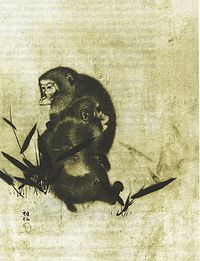Kyoto school (art)

The Kyoto school (京都派 -ha) was a collection of several styles and schools of Japanese painting of the late Edo period. Though there are many broad similarities between the styles within the school, these styles display key differences that separate them. Many were in fact reactions to one another, an artist or group of artists seeking to express themselves differently from those around them.[1] Those subscribers of the Kyoto school found themselves at odds with the state sanctioned Kanō school, thus contributing to the vague nature of the former.
Kakuzo Okakura, predominant Japanese art historian of the late nineteenth and early twentieth centuries, traced the origins of the Kyoto school to the schools of both Manchu-shin and Ming dynasties in China. The two latter schools focused on the power of the artist as a lay person or scholar, as opposed to a professional.[1] Okakura is swift with a critique of the Kyoto school's attempts to repurpose the Japanese tradition of copying works from other (predominantly Chinese) cultures, a technique known as utsushi.
[2]One of the more prominent schools under the Kyoto school umbrella was the Shijō school, named after the street where many of the artists had their studios. Shijō (四条) literally translates to 'fourth avenue.' This school sought to produce a synthesis of the more realistic style of Maruyama Ōkyo with that of the nanga or Southern School styles. Mori Sosen was one of the more prominent painters in the Shijō school.
The nanga or Southern School, meanwhile, rebelled against the realism of Ōkyo and the Shijō artists, seeking to return to the inspiration and style of China's Southern School.
- ^ a b Okakura, Kakuzo (2005). Ideals of the East: The Spirit of Japanese Art. Mineola, New York: Dover Publications, Inc. pp. 87–89. ISBN 978-0-486-44024-8.
- ^ Kameda-Madar, Kazuko (2014-09-01). "Copying and Theory in Edo-Period Japan (1615–1868)". Art History. 37 (4): 708–727. doi:10.1111/1467-8365.12111. ISSN 1467-8365.
